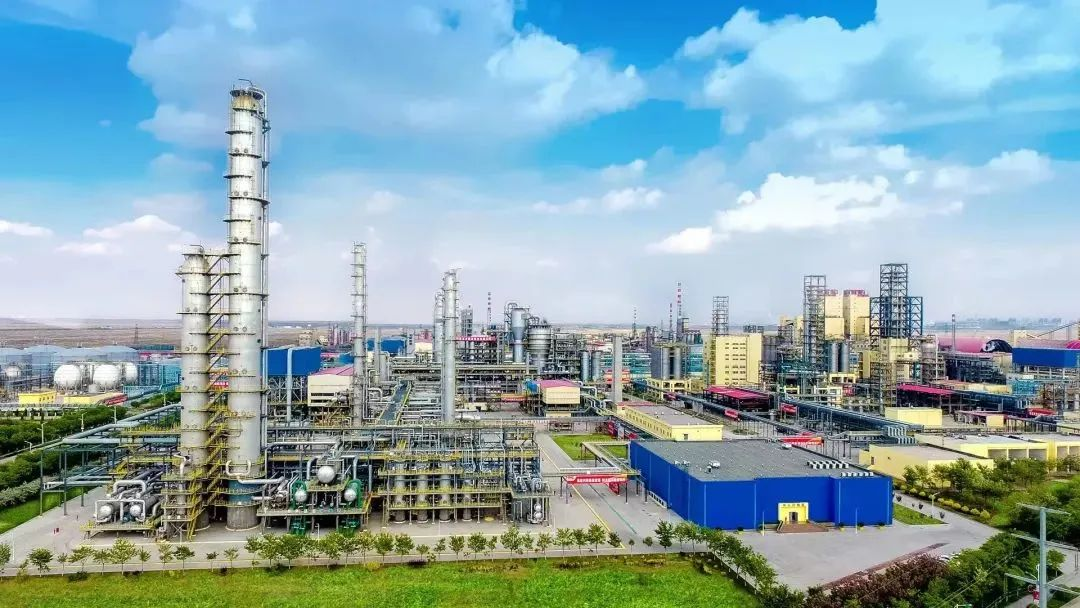There are towering giant installations one after another, and the milky white pipes circling in the air cover the factory area, accumulating heat. This “steel forest” on the Gobi Desert is the Ningdong Industrial Base of the Ningxia Hui Autonomous Region.
“After nearly 20 years of cultivation, the coal chemical industry system in Ningdong Industrial Base has been improved, but it still faces many difficulties.” On the desk, Tian Yanhu, director of the Economic Development Bureau of Ningdong Management Committee, drew the industrial production flow chart, “For example, production Aerospace plastics require more than a hundred links, and we only occupy the first dozen or so links in the production of ethylene and propylene, and the subsequent high-end processes such as material polymerization are in the hands of downstream enterprises in the east.”

▲ Image source Ningxia Ningdong Energy and Chemical Industry Base
How did Ningdong break through?
“Use the formed basic chemical raw material production capacity to attract downstream enterprises and make them interconnected, so that ‘scale benefits’ become ‘structural benefits’ and ‘agglomeration benefits’.” Tian Yanhu said.
In the production workshop of Ningxia Baichuan New Material Co., Ltd., there is a kind of black powder. When you pinch a pinch, the powder has no grainy feeling and slips from your hand like running water. “This small molecule graphite is the material for making the negative electrode of lithium batteries.” Cao Shengping, general manager of the company, introduced.
This Jiangsu-based manufacturer is a “foreign visitor” attracted by the Ningdong Industrial Base and an important participant in the production of lithium batteries in the country. When choosing to invest in Ningdong, Cao Shengping valued the supporting raw material industry chain here. Much of the pitch needed for the production of small molecule graphite is provided by Baofeng Energy, which is also in the Ningdong base. “In the same park, two factories have established raw material transportation pipelines, which saves a lot of transportation, storage and loss costs.”
Such cooperation is not uncommon in Ningdong.
Sinopec Great Wall Energy Chemical (Ningxia) Co., Ltd. is an “old member” of Ningdong Industrial Base, with an annual production of 92,000 tons of polytetrahydrofuran and 200,000 tons of 1,4-butanediol (BDO). In the past, there were no downstream processing enterprises locally, and the produced polytetrahydrofuran could only be exported to Zhejiang, Guangdong and other places, and the transportation cost was high. In 2017, Taihe New Materials Co., Ltd. settled in Ningdong, and Ningxia Nenghua supplied the polytetrahydrofuran produced as raw materials to Taihe Company to produce spandex and aramid fibers. “From January to April this year, the output of polytetrahydrofuran products produced by our company increased by 7.5% year-on-year, hitting a new high since the project was put into operation, and became the main force in the supply of new material spandex raw materials in the park. The cooperation between the factory and the area gave us more confidence in increasing production.” Ningxia Wei Keke, head of Nenghua General Research Office, said.
Today, walking around the Ningdong Industrial Park, you can see thick silver-white pipes criss-crossing around each company. There are not only steam and water pipelines built uniformly in the park, but also carefully planned raw material transportation channels. It is this kind of pipeline that allows companies to communicate with each other.
Ningdong Industrial Base is a national modern coal chemical industry demonstration zone. Here, carbon atoms are stripped and reorganized to form various single-carbon and multi-carbon chemical products, and finally become clothing, kitchen utensils, and even aircraft and high-speed rail accessories.
In 2022, the Ningdong Management Committee issued the “Implementation Plan for High-Quality Development of Nine Segmented Industrial Chains and High-end Industrial Clusters in Ningdong Base”, planning to use mature production capacity of basic chemical raw materials to attract downstream enterprises within three to five years. “In the future, we will further turn the scale benefits of industrial development into structural benefits, and rely on the existing industrial advantages to embark on a high-quality development path with linkage of industrial layout and prominent agglomeration effect.” Tian Yanhu said.



 微信扫一扫打赏
微信扫一扫打赏
